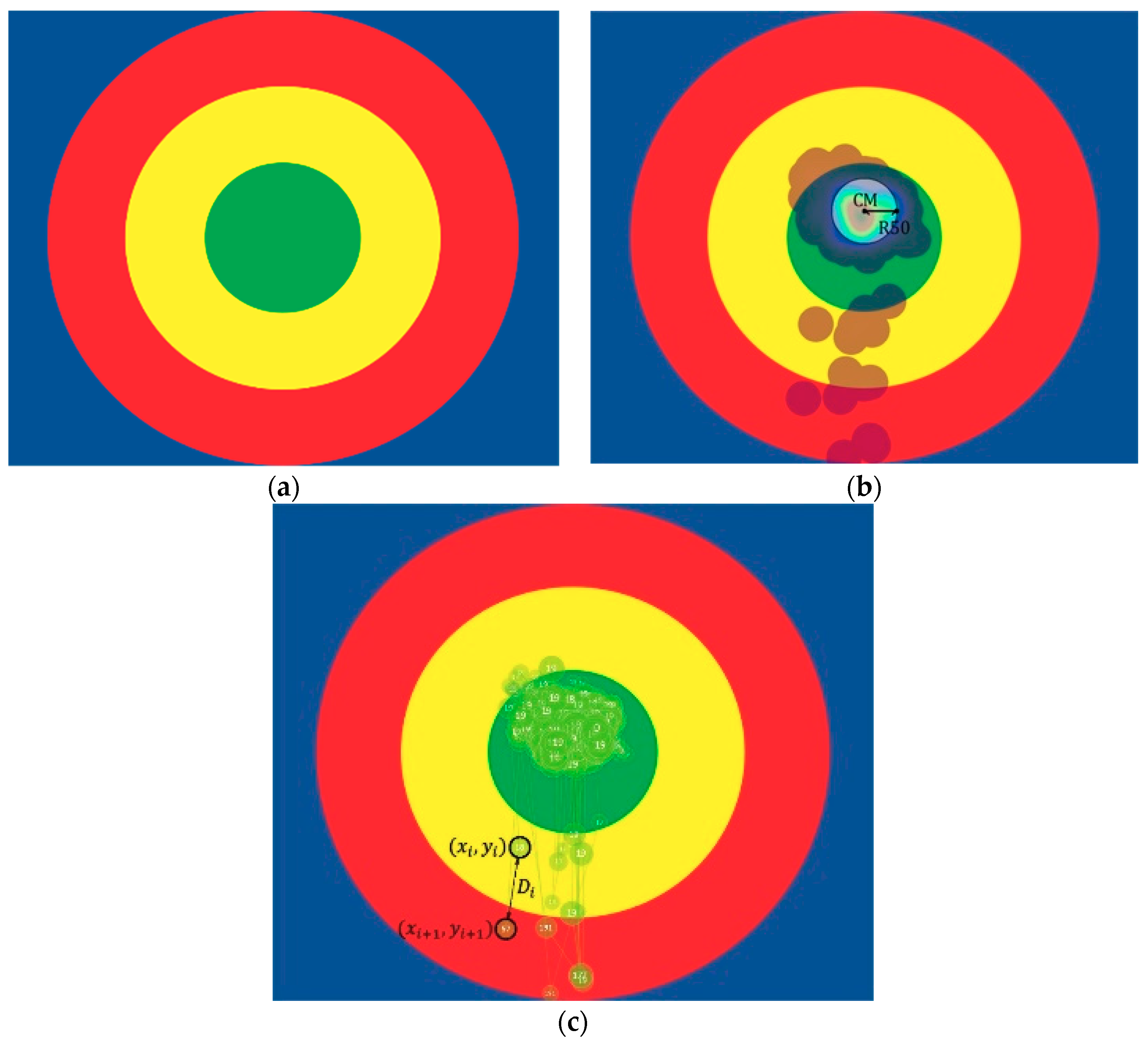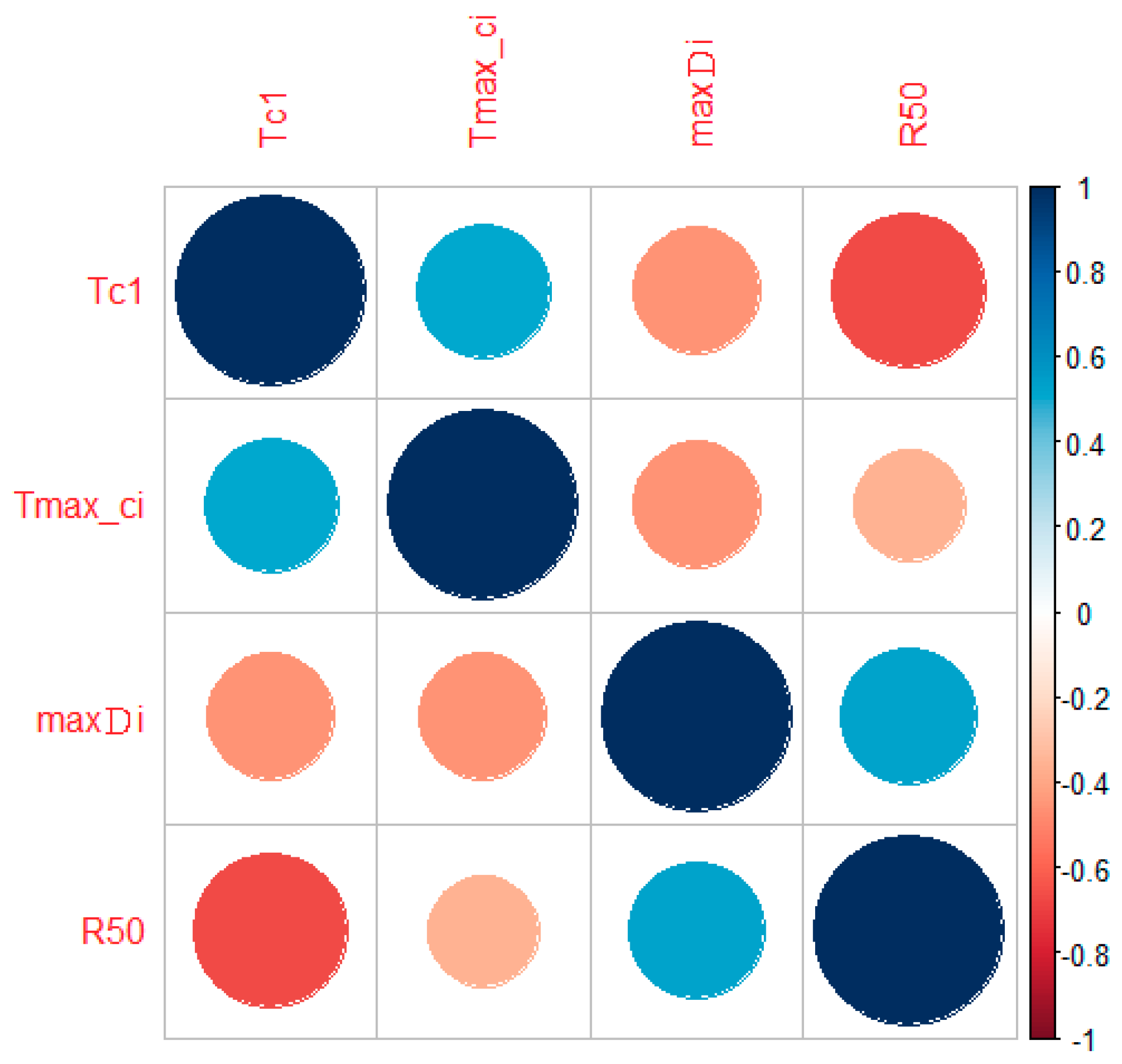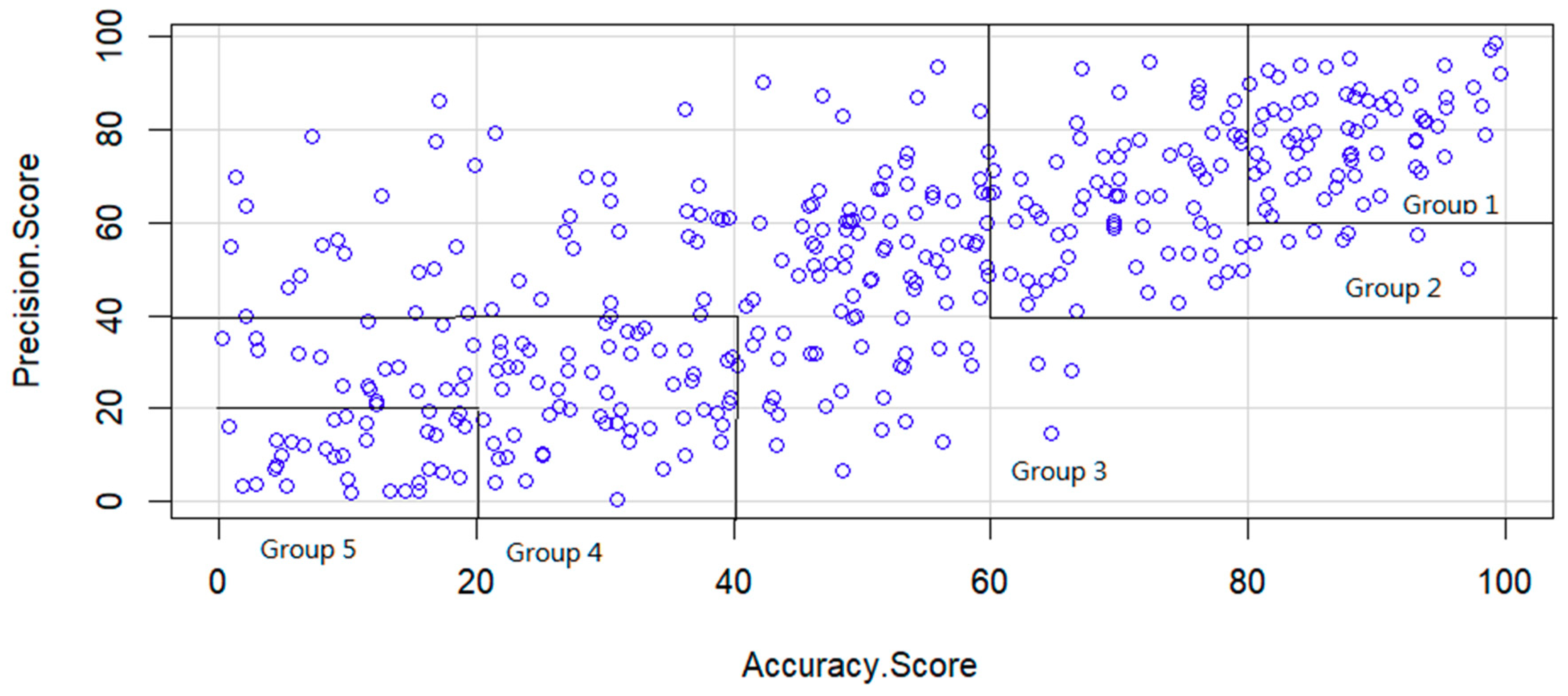Using Eye Tracking to Assess Gaze Concentration in Meditation
Abstract
:1. Introduction
2. Materials and Methods
2.1. Data Recording
2.2. Eye Tracker Feature Definition
2.3. Cardiovascular and Sleep Quality Parameters
2.4. Statistics
3. Results
3.1. Verification of the Features Defined for Eye Tracking
- Group 1, excellent: the accuracy and precision scores were both >80, accounting for approximately 8.5% of all subjects;
- Group 2, satisfactory: the accuracy and precision scores were both >60 (excluding scores that were >80), accounting for approximately 19.3% of all subjects;
- Group 3, average: the accuracy and precision scores did not belong to any other group, accounting for approximately 44.34% of all subjects;
- Group 4, below average: the accuracy and precision scores were both <40 (excluding scores that were both <20), accounting for approximately 19.3% of all subjects;
- Group 5, unsatisfactory: the accuracy and precision scores were both <20, accounting for approximately 8.5% of all subjects
3.2. Verification of Cardiovascular and Sleep Quality Features
4. Discussion
5. Conclusions
Ethical Statements
Author Contributions
Funding
Acknowledgments
Conflicts of Interest
Appendix
References
- Lo, P.-C.; Huang, M.-L. Exploring Preventive Power of Ten-Mailuns Actuation in Chan Ding. Int J. Prev Med. Res. 2015, 1, 27. [Google Scholar]
- Chang, K.-M.; Chun, Y.-T.; Chen, S.-H.; Lu, L.; Su, H.-T.J.; Liang, H.-M.; Santhosh, J.; Ching, C.T.-S.; Liu, S.-H. The evaluation of physical stillness with wearable chest and arm accelerometer during Chan Ding practice. Sensors 2016, 16, 1126. [Google Scholar]
- Wu, S.-D.; Lo, P.-C. Cardiorespiratory phase synchronization during normal rest and inward-attention meditation. Int. J. Cardiol. 2010, 141, 325–328. [Google Scholar] [CrossRef]
- CogniFit. Attention, One of our Cognitive Domains. Available online: https://www.cognifit.com/attention (accessed on 1 April 2019).
- Conners, C.K.; Staff, M.; Connelly, V.; Campbell, S.; MacLean, M.; Barnes, J. Conners’ continuous performance Test II (CPT II v. 5). Multi-Health Syst. Inc. 2000, 29, 175–196. [Google Scholar]
- Stroop, J.R. Studies of interference in serial verbal reactions. J.Exp. Psychol. Gen. 1992, 121, 15. [Google Scholar] [CrossRef]
- Greenberg, L.; Kindschi, C.; Corman, C.L. TOVA: Test of Variables of Attention; Universal Attention Disorders: Los Alamitos, CA, USA, 1996. [Google Scholar]
- Conners, C.K. Manual for Conner’ Rating Scales: Conners’ Teaching Rating Scales, Conners’ Parent Rating Scales; Multi-Health Systems, Incorporated: Toronto, ON, Canada, 1989. [Google Scholar]
- Hooper, E.H. Hooper Visual Organization Test (VOT); Western Psychological Services: Portland, OR, USA, 1983. [Google Scholar]
- Shah, T.M.; Weinborn, M.; Verdile, G.; Sohrabi, H.R.; Martins, R.N. Enhancing cognitive functioning in healthly older adults: A systematic review of the clinical significance of commercially available computerized cognitive training in preventing cognitive decline. Neuropsychol. Rev. 2017, 27, 62–80. [Google Scholar]
- Pichel, F.; Zamarrón, C.; Magán, F.; Rodríguez, J.R. Sustained attention measurements in obstructive sleep apnea and risk of traffic accidents. Respir. Med. 2006, 100, 1020–1027. [Google Scholar] [CrossRef] [PubMed]
- Chiu, Y.-C.; Algase, D.; Whall, A.; Liang, J.; Liu, H.-C.; Lin, K.-N.; Wang, P.-N. Getting lost: directed attention and executive functions in early Alzheimer’s disease patients. Dement. Geriatr. Cogn. Disord. 2004, 17, 174–180. [Google Scholar] [CrossRef] [PubMed]
- Willcutt, E.G.; Doyle, A.E.; Nigg, J.T.; Faraone, S.V.; Pennington, B.F. Validity of the executive function theory of attention-deficit/hyperactivity disorder: A meta-analytic review. Biol. Psychiatry 2005, 57, 1336–1346. [Google Scholar] [CrossRef]
- Mostert, J.C.; Onnink, A.M.H.; Klein, M.; Dammers, J.; Harneit, A.; Schulten, T.; van Hulzen, K.J.; Kan, C.C.; Slaats-Willemse, D.; Buitelaar, J.K. Cognitive heterogeneity in adult attention deficit/hyperactivity disorder: A systematic analysis of neuropsychological measurements. Eur. Neuropsychopharmacol. 2015, 25, 2062–2074. [Google Scholar] [CrossRef]
- Walker, H.E.; Trick, L.M. Mind-wandering while driving: The impact of fatigue, task length, and sustained attention abilities. Transp. Res. Part F: Traffic Psychol. Behav. 2018, 59, 81–97. [Google Scholar] [CrossRef]
- Leszczyński, M.; Staudigl, T. Memory-guided attention in the anterior thalamus. Neurosci. Biobehav. Rev. 2016, 66, 163–165. [Google Scholar] [CrossRef] [PubMed]
- Mohamed, Z.; El Halaby, M.; Said, T.; Shawky, D.; Badawi, A. Characterizing Focused Attention and Working Memory Using EEG. Sensors 2018, 18, 3743. [Google Scholar] [CrossRef]
- Liu, N.-H.; Chiang, C.-Y.; Chu, H.-C. Recognizing the degree of human attention using EEG signals from mobile sensors. Sensors 2013, 13, 10273–10286. [Google Scholar] [CrossRef] [PubMed]
- Maffei, A.; Angrilli, A. Spontaneous eye blink rate: An index of dopaminergic component of sustained attention and fatigue. Int. J. Psychophysiol. 2018, 123, 58–63. [Google Scholar] [CrossRef]
- LaBerge, D.; Buchsbaum, M.S. Positron emission tomographic measurements of pulvinar activity during an attention task. J. Neurosci. 1990, 10, 613–619. [Google Scholar] [CrossRef] [PubMed]
- von Rhein, D.; Mennes, M.; van Ewijk, H.; Groenman, A.P.; Zwiers, M.P.; Oosterlaan, J.; Heslenfeld, D.; Franke, B.; Hoekstra, P.J.; Faraone, S.V. The NeuroIMAGE study: a prospective phenotypic, cognitive, genetic and MRI study in children with attention-deficit/hyperactivity disorder. Design and descriptives. Eur. Child Adolesc. Psychiatry 2015, 24, 265–281. [Google Scholar] [PubMed]
- Alomari, R.A.; Fernandez, M.; Banks, J.B.; Acosta, J.; Tartar, J.L. Acute stress dysregulates the LPP ERP response to emotional pictures and impairs sustained attention: time-sensitive effects. Brain Sci. 2015, 5, 201–219. [Google Scholar] [CrossRef]
- Naqvi, R.A.; Arsalan, M.; Batchuluun, G.; Yoon, H.S.; Park, K.R. Deep learning-based gaze detection system for automobile drivers using a NIR camera sensor. Sensors 2018, 18, 456. [Google Scholar]
- Harrison, A.J.; Gibb, B.E. Attentional biases in currently depressed children: An eye-tracking study of biases in sustained attention to emotional stimuli. J. Clin. Child. Adolesc. Psychol. 2015, 44, 1008–1014. [Google Scholar] [CrossRef]
- Liang, C.-W.; Tsai, J.-L.; Hsu, W.-Y. Sustained visual attention for competing emotional stimuli in social anxiety: an eye tracking study. J. Behav. Ther. Exp. Psychiatry 2017, 54, 178–185. [Google Scholar] [CrossRef] [PubMed]
- Lange, B.; Hunfalvay, M.; Murray, N.; Roberts, C.-M.; Bolte, T. Reliability of computerized eye-tracking reaction time tests in non-athletes, athletes, and individuals with traumatic brain injury. Optom. Vis. Perform. 2018, 6, 119–129. [Google Scholar]
- Fortenbaugh, F.C.; Rothlein, D.; McGlinchey, R.; DeGutis, J.; Esterman, M. Tracking behavioral and neural fluctuations during sustained attention: A robust replication and extension. NeuroImage 2018, 171, 148–164. [Google Scholar] [CrossRef]
- Frutos-Pascual, M.; Garcia-Zapirain, B. Assessing visual attention using eye tracking sensors in intelligent cognitive therapies based on serious games. Sensors 2015, 15, 11092–11117. [Google Scholar] [CrossRef] [PubMed]
- International, M. MangoldVision-Professional Software for Eye Tracking. Available online: https://www.mangold-international.com/en/products/software/eye-tracking-with-mangoldvision (accessed on 1 April 2019).
- Tsai, P.-S.; Wang, S.-Y.; Wang, M.-Y.; Su, C.-T.; Yang, T.-T.; Huang, C.-J.; Fang, S. Psychometric evaluation of the Chinese version of the Pittsburgh Sleep Quality Index (CPSQI) in primary insomnia and control subjects. Qual. Life Res. 2005, 14, 1943–1952. [Google Scholar] [CrossRef]
- Engbert, R.; Kliegl, R.J.V.r. Microsaccades uncover the orientation of covert attention. Vision Res. 2003, 43, 1035–1045. [Google Scholar] [CrossRef]
- Martinez-Conde, S. Fixational eye movements in normal and pathological vision. Prog. Brain Res. 2006, 154, 151–176. [Google Scholar] [PubMed]
- Martinez-Conde, S.; Macknik, S.L.; Troncoso, X.G.; Hubel, D.H. Microsaccades: A neurophysiological analysis. Trends Neurosci. 2009, 32, 463–475. [Google Scholar] [CrossRef]
- Otero-Millan, J.; Troncoso, X.G.; Macknik, S.L.; Serrano-Pedraza, I.; Martinez-Conde, S.J.J.o.v. Saccades and microsaccades during visual fixation, exploration, and search: foundations for a common saccadic generator. J. Vis. 2008, 8, 21. [Google Scholar] [CrossRef] [PubMed]
- Gowen, E.; Abadi, R.; Poliakoff, E.; Hansen, P.; Miall, R.J.B.r. Modulation of saccadic intrusions by exogenous and endogenous attention. Brain Res. 2007, 1141, 154–167. [Google Scholar] [CrossRef]
- Thaler, L.; Schütz, A.C.; Goodale, M.A.; Gegenfurtner, K.R.J.V.R. What is the best fixation target? The effect of target shape on stability of fixational eye movements. Vis. Res. 2013, 76, 31–42. [Google Scholar] [CrossRef]
- Ukwade, M.T.; Bedell, H.E.J.O.; Optometry, v.s.o.p.o.t.A.A.o. Stability of oculomotor fixation as a function of target contrast and blur. Optom. Vis. Sci. 1993, 70, 123–126. [Google Scholar] [CrossRef]
- Kumari, V.; Antonova, E.; Wright, B.; Hamid, A.; Hernandez, E.M.; Schmechtig, A.; Ettinger, U.J.C. The mindful eye: Smooth pursuit and saccadic eye movements in meditators and non-meditators. Conscious. Cogn. 2017, 48, 66–75. [Google Scholar] [CrossRef]
- Matiz, A.; Crescentini, C.; Fabbro, A.; Budai, R.; Bergamasco, M.; Fabbro, F.J.P.o. Spontaneous eye movements during focused-attention mindfulness meditation. PLoS ONE 2019, 14, e0210862. [Google Scholar] [CrossRef] [PubMed]
- McGibbon, C.A.; Krebs, D.E.; Wolf, S.L.; Wayne, P.M.; Scarborough, D.M.; Parker, S.W.J.J.o.V.R. Tai Chi and vestibular rehabilitation effects on gaze and whole-body stability. J. Vestib. Res. 2004, 14, 467–478. [Google Scholar] [PubMed]




| All | Group 1 | Group 2 | Group 3 | Group 4 | Group 5 | |
|---|---|---|---|---|---|---|
| SYS | 116.72 (15.72) | 115.3 (11.3) a* | 114.1 (10.4) | 117.3 (17.0) | 115.3 (15.4) | 123.4 (18.9) |
| DIA | 80.47 (10.16) | 81.8 (10.7) | 79.8 (9.9) | 80.1 (9.5) | 79.8 (10.8) | 84.1 (11.2) |
| HR | 76.34 (11.13) | 75.8 (11.9) | 77.2 (10.1) | 75.8 (10.6) | 77.9 (13.9) | 72.3 (9.6) |
| HRV | 40.43 (17.27) | 39.7 (15.3) | 42.0 (17.4) | 40.0 (16.6) | 38.7 (17.7) | 45.5 (21.5) |
| LF% | 56.71 (19.63) | 59.6 (21.6) | 56.7 (21.0) | 55.3 (18.7) | 57.5 (18.0) | 59.7 (24.2) |
| HF% | 43.29 (19.63) | 40.4 (21.6) | 43.3 (21.0) | 44.8 (18.7) | 42.5 (18.0) | 40.3 (24.2) |
| LF | 579.13 (824.55) | 551.8 (802.9) | 730.6 (1230.1) | 503.6 (606.2) | 528.2 (702.5) | 820.3 (949.0) |
| HF | 357.79 (414.96) | 279.7 (195.3) | 361.7 (265.8) | 369.3 (461.4) | 325.0 (408.0) | 465.0 (602.7) |
| LF/HF(%) | 2.24 (3.05) | 3.1 (3.9) | 2.4 (3.2) | 1.9 (2.1) | 2.3 (4.1) | 3.0 (3.2) |
| HRV age | 38.37 (18.88) | 38.3 (21.0) | 36.1 (16.3) | 38.7 (19.1) | 40.5 (19.7) | 35.0 (19.7) |
| Real Age | 39.17 (12.95) | 38.0 (11.4) | 39.1 (11.5) | 39.0 (12.8) | 40.8 (14.4) | 36.3 (14.8) |
| PSQI | 8.53 (3.65) | 7.9 (3.1) b* | 8.7 (3.6) | 8.3 (3.7) | 8.9 (3.9) | 9.5 (3.4) |
| Parameter | PSQI 1–5 (N = 66) | PSQI > 5 (N = 240) |
|---|---|---|
| 43.74 (0.15) | 43.69 (0.15) | |
| 4.78 (4.51) | 5.51(6.12) | |
| maxDi | 740.75 (175.18) | 742.81 (198.88) |
| R50 | 77.45 (41.31) | 82.95 (53.40) |
| Accuracy score | 48.64 (26.27) | 50.28 (27.27) |
| Precision score | 50.49 (24.41) | 49.93 (25.3) |
© 2019 by the authors. Licensee MDPI, Basel, Switzerland. This article is an open access article distributed under the terms and conditions of the Creative Commons Attribution (CC BY) license (http://creativecommons.org/licenses/by/4.0/).
Share and Cite
Chang, K.-M.; Chueh, M.-T.W. Using Eye Tracking to Assess Gaze Concentration in Meditation. Sensors 2019, 19, 1612. https://doi.org/10.3390/s19071612
Chang K-M, Chueh M-TW. Using Eye Tracking to Assess Gaze Concentration in Meditation. Sensors. 2019; 19(7):1612. https://doi.org/10.3390/s19071612
Chicago/Turabian StyleChang, Kang-Ming, and Miao-Tien Wu Chueh. 2019. "Using Eye Tracking to Assess Gaze Concentration in Meditation" Sensors 19, no. 7: 1612. https://doi.org/10.3390/s19071612
APA StyleChang, K.-M., & Chueh, M.-T. W. (2019). Using Eye Tracking to Assess Gaze Concentration in Meditation. Sensors, 19(7), 1612. https://doi.org/10.3390/s19071612





